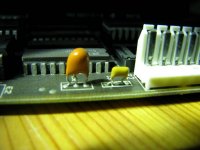snq
Experienced Member
Thanks to the help I got here my 5170 is now up and running, so it was time to start with the 5160.
Its original power supply was dead and its contents have been replaced with a modified generic AT power supply - original wiring from the XT PSU hooked up to the inners of the newer PSU, a couple mounting brackets on the inside to mount the new contents, just by looking at it you wouldn't know the difference. Weight and noise wise - big difference!
Anyway, this machine is behaving quite weird. Wether or not it powers up seems to depend on what kind of stuff is attached to the mainboard. As soon as I attach the P8 connector to the mainboard, it will not power up. No disk spinning, the PSU fan doesn't start, nothing happens whatsoever. Without the P8, it works kind of fine :-? It will boot to floppy etc, everything seems fine. Until I put in a quadboard, then it's completely dead again. The same quadboard works fine in my AT.
I've tried removing everything from the system leaving just the mainboard with nothing connected to it (no keyboard, nothing) and it just will not power up when P8 is connected. With P8 disconnected, it's all fine again and I at least get a couple of beeps because nothing is connected.
Obviously the PSU is a bit of a hack, but I don't see why it wouldn't work. I don't think I'm the first person to replace it with something else. This PSU is rated at 145W, which should be plenty for an XT I think.
I've tested with another generic AT PSU with +5V on P8 removed, and that gives exactly the same result.
So I'm kind of looking for an explanation for why it's completely dead with P8 connected, and why it actually works in most cases with P8 disconnected. I wasn't exactly expecting it to do anything at all but I just had to test.
Its original power supply was dead and its contents have been replaced with a modified generic AT power supply - original wiring from the XT PSU hooked up to the inners of the newer PSU, a couple mounting brackets on the inside to mount the new contents, just by looking at it you wouldn't know the difference. Weight and noise wise - big difference!
Anyway, this machine is behaving quite weird. Wether or not it powers up seems to depend on what kind of stuff is attached to the mainboard. As soon as I attach the P8 connector to the mainboard, it will not power up. No disk spinning, the PSU fan doesn't start, nothing happens whatsoever. Without the P8, it works kind of fine :-? It will boot to floppy etc, everything seems fine. Until I put in a quadboard, then it's completely dead again. The same quadboard works fine in my AT.
I've tried removing everything from the system leaving just the mainboard with nothing connected to it (no keyboard, nothing) and it just will not power up when P8 is connected. With P8 disconnected, it's all fine again and I at least get a couple of beeps because nothing is connected.
Obviously the PSU is a bit of a hack, but I don't see why it wouldn't work. I don't think I'm the first person to replace it with something else. This PSU is rated at 145W, which should be plenty for an XT I think.
I've tested with another generic AT PSU with +5V on P8 removed, and that gives exactly the same result.
So I'm kind of looking for an explanation for why it's completely dead with P8 connected, and why it actually works in most cases with P8 disconnected. I wasn't exactly expecting it to do anything at all but I just had to test.

